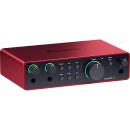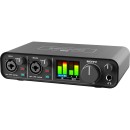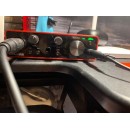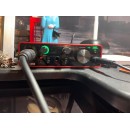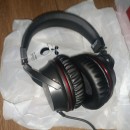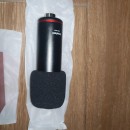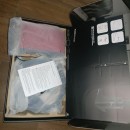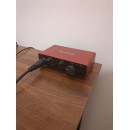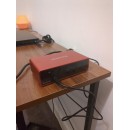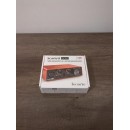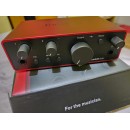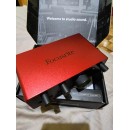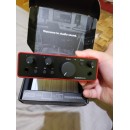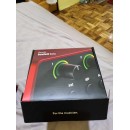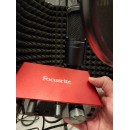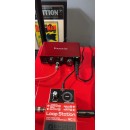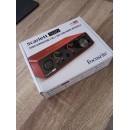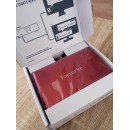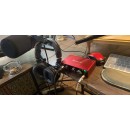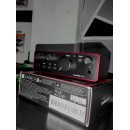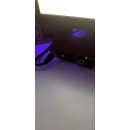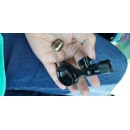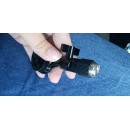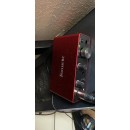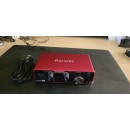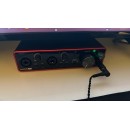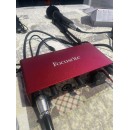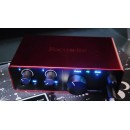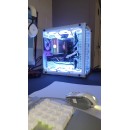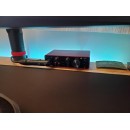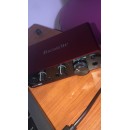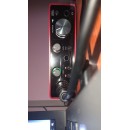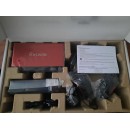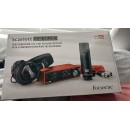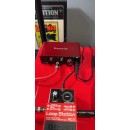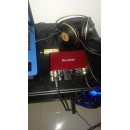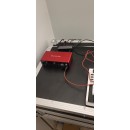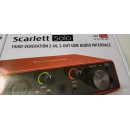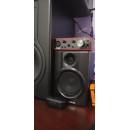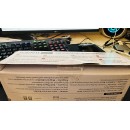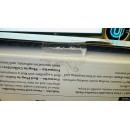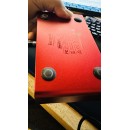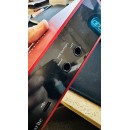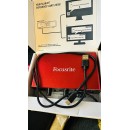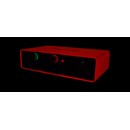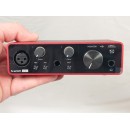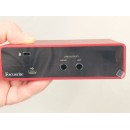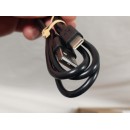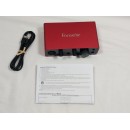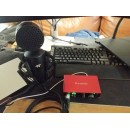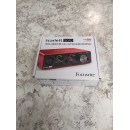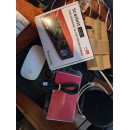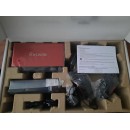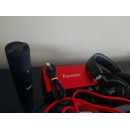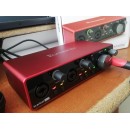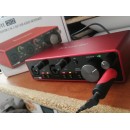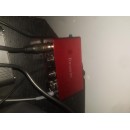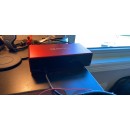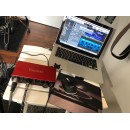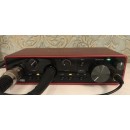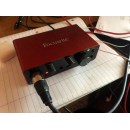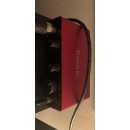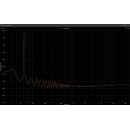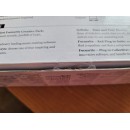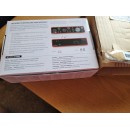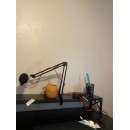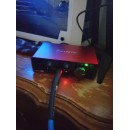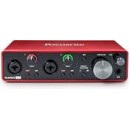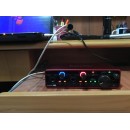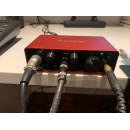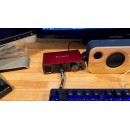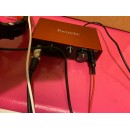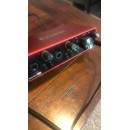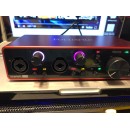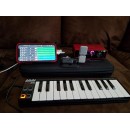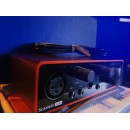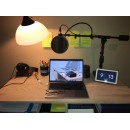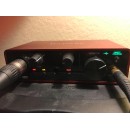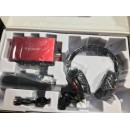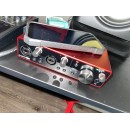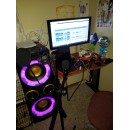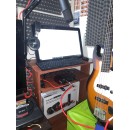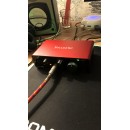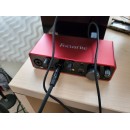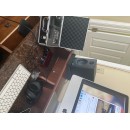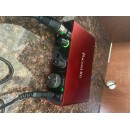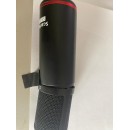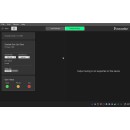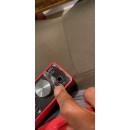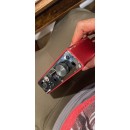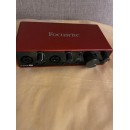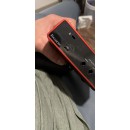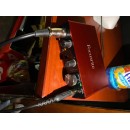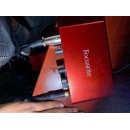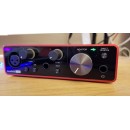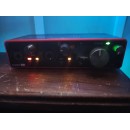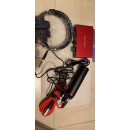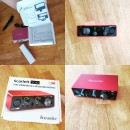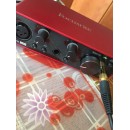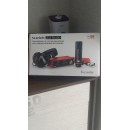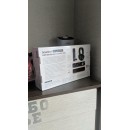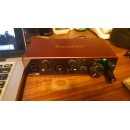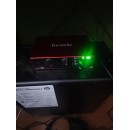MOTU M2 vs Focusrite Scarlett 2i2 (4th Gen): Comprehensive USB-C Audio Interface Comparison
The Focusrite Scarlett 2i2 (4th Gen) continues the legacy of its predecessors with improved preamps, higher-resolution audio, and a sleek, user-friendly design. It provides two combo inputs (XLR/TRS) with Focusrite’s acclaimed preamps, delivering clear and pristine sound quality. The Air mode, an emulation of the classic Focusrite ISA preamp, adds brightness and presence to vocals and instruments. With 24-bit/192kHz converters, it ensures high-fidelity audio capture. The 4th generation also boasts ultra-low latency, making real-time monitoring seamless and efficient. The Scarlett 2i2 includes a comprehensive software bundle featuring Ableton Live Lite, Pro Tools First, and a collection of Focusrite’s plug-ins, providing users with a complete package to start their recording projects.
On the other hand, the MOTU M2 USB-C Audio/MIDI Interface stands out with its ESS Sabre32 Ultra DAC technology, offering outstanding audio performance with a dynamic range of 120dB. This translates to exceptionally detailed and nuanced sound reproduction. The M2 also features a full-color LCD screen that displays input and output levels, a rare and valuable addition in this price range, allowing for precise monitoring. It includes two combo inputs with high-quality preamps and provides MIDI I/O, making it a versatile choice for users who need MIDI connectivity for their instruments or controllers. The M2 supports 24-bit/192kHz audio and boasts ultra-low latency performance, ensuring smooth and efficient recording sessions. The bundled software includes Performer Lite and Ableton Live Lite, along with a suite of virtual instruments and effects, giving users a robust starting point for music production.
In summary, both the Focusrite Scarlett 2i2 (4th Gen) and MOTU M2 offer high-quality audio interfaces with professional-grade features. The Scarlett 2i2 is ideal for users seeking excellent preamps and a rich software bundle, while the MOTU M2 appeals to those who prioritize top-tier DAC performance, visual level monitoring, and MIDI connectivity. Your choice between the two will depend on your specific needs and preferences in an audio interface.
Specifications, Advantages, and Disadvantages of MOTU M2 and Focusrite Scarlett 2i2 (4th Gen)
| User Rating Based on Analysis of Reviews | |
|---|---|
|
Show More |
| Pros: | |
|---|---|
|
|
| Cons: | |
|---|---|
|
|
| Key Specs | |
|---|---|
| Channels of I/O | |
| Analog: 2 Inputs / 2 Outputs at 192 kHz |
Analog: 2 Inputs / 2 Outputs |
| Maximum Sampling Rate | |
| 192 kHz / 24-Bit | 192 kHz / 24-Bit |
| Number of Microphone Inputs | |
| 2 | 2 Preamps |
| Analog Audio I/O | |
| 2x XLR 3-Pin Balanced Mic Input 2x 1/4" TRS Balanced/Unbalanced Line/Hi-Z Input (Front Panel) 2x 1/4" TRS Balanced Monitor Output 1x 1/4" TRS Headphone Output (Front Panel) |
2x Combo XLR-1/4" TRS Balanced/Unbalanced Mic/Line/Hi-Z Input 1x 1/4" TRS Unbalanced Headphone Output 2x 1/4" TRS Balanced Line Output (DC-Coupled) 2x RCA TS Unbalanced Line Output |
| Host Connection | |
| 1x USB-C | 1x USB-C |
| OS Compatibility | |
| macOS Windows |
macOS 10.11 or Later Windows 7 or Later 9 or Later |
| Power Requirements | |
| USB Bus Power, USB Power Adapter (Not Included) | USB Bus Power |
In terms of channels of I/O, both interfaces provide 2 analog inputs and 2 analog outputs. The Focusrite Scarlett 2i2 features 2 XLR balanced mic inputs and 2 1/4" TRS balanced/unbalanced line/Hi-Z inputs on the front panel, along with 2 1/4" TRS balanced monitor outputs and a 1/4" TRS headphone output also on the front panel. The MOTU M2, on the other hand, offers 2 combo XLR-1/4" TRS balanced/unbalanced mic/line/Hi-Z inputs, a 1/4" TRS unbalanced headphone output, 2 1/4" TRS balanced line outputs (DC-coupled), and additionally 2 RCA TS unbalanced line outputs.
Regarding the number of microphone inputs, both interfaces provide 2 microphone preamps. However, the MOTU M2 specifies the use of combo inputs which can accept both XLR and 1/4" TRS connectors, offering a bit more flexibility in terms of input options.
For digital audio I/O, the Focusrite Scarlett 2i2 does not offer any digital audio inputs or outputs, while the MOTU M2 also does not include digital audio I/O, keeping the focus on its analog connectivity.
Looking at host connections, both interfaces utilize a USB-C connection, ensuring fast and reliable data transfer. In terms of OS compatibility, the Focusrite Scarlett 2i2 is compatible with macOS and Windows operating systems, whereas the MOTU M2 supports macOS 10.11 or later and Windows 7 or later, which includes broader compatibility with older Windows systems.
When it comes to power requirements, both interfaces are powered via USB bus power. However, the Focusrite Scarlett 2i2 also mentions the option to use a USB power adapter, although it is not included in the package.
In summary, while both the Focusrite Scarlett 2i2 and the MOTU M2 offer similar high-resolution audio capabilities and essential features for recording and monitoring, the Scarlett 2i2 emphasizes simplicity and straightforward analog connectivity, whereas the MOTU M2 provides a bit more versatility with its combo inputs and additional RCA outputs. Both interfaces are highly compatible with modern operating systems and are powered through USB, making them convenient and portable solutions for various audio recording needs.
| General | |
|---|---|
| Channels of I/O | |
| Analog: 2 Inputs / 2 Outputs at 192 kHz |
Analog: 2 Inputs / 2 Outputs |
| Maximum Sampling Rate | |
| 192 kHz / 24-Bit | 192 kHz / 24-Bit |
| Number of Microphone Inputs | |
| 2 | 2 Preamps |
| Built-In Microphone | |
| Input Level Adjustment | |
| 2x Knob | 2x Knob |
| Expansion Slots | |
Both the Focusrite Scarlett 2i2 and the MOTU M2 offer 2 analog inputs and 2 analog outputs, supporting a maximum sampling rate of 192 kHz at 24-bit resolution. This ensures high-quality audio recording and playback for both interfaces. Each device also features 2 microphone inputs, providing flexibility for recording vocals or instruments with microphones.
Neither the Focusrite Scarlett 2i2 nor the MOTU M2 includes built-in DSP (Digital Signal Processing), which means any effects or signal processing would need to be handled by external software or hardware. Additionally, both interfaces lack built-in microphones, staying true to their roles as dedicated audio interfaces rather than hybrid recording devices.
For input level adjustment, both interfaces offer 2 knobs, allowing users to manually control the levels of their input signals for optimal recording quality. Furthermore, neither the Scarlett 2i2 nor the MOTU M2 includes expansion slots, indicating that they are designed to be compact, straightforward solutions without the need for additional modular components.
In summary, the Focusrite Scarlett 2i2 USB-C Audio Interface (4th Generation) and the MOTU M2 USB-C Audio/MIDI Interface are quite similar in their core features, each providing 2 inputs and outputs, high-resolution audio quality, and basic but effective input level control. The choice between the two may come down to brand preference, additional features, or other aspects not covered in these core specifications.
| Signal Processing | |
|---|---|
| Gain/Trim Range | |
| Mic/Line Inputs: Up to +69 dB Hi-Z Inputs: 62 dB |
Mic Inputs: 0 dB to +60 dB Line/Hi-Z Inputs: 0 dB to +57 dB |
In contrast, the MOTU M2 offers a gain/trim range of 0 dB to +60 dB for mic inputs and 0 dB to +57 dB for line/Hi-Z inputs. While this range is slightly narrower compared to the Scarlett 2i2, it is still sufficient for many recording scenarios, particularly for users who do not need the extra headroom that the Scarlett provides.
Additionally, the MOTU M2 lacks certain features such as a pad, high-pass filter, and solo/mute options. These omissions might influence a user's decision, especially if they require these functionalities for their recording setup. The absence of a pad means the MOTU M2 might be less suitable for handling very high-level signals without distortion. Similarly, the lack of a high-pass filter and solo/mute options may affect the ease of managing and refining audio inputs directly through the interface.
Overall, the choice between the Focusrite Scarlett 2i2 (4th Generation) and the MOTU M2 will largely depend on the user's specific needs regarding gain flexibility and additional features like pads and filters. The Scarlett 2i2 stands out with its higher gain range and potentially more versatile performance with various input sources, while the MOTU M2 remains a solid competitor with adequate gain capabilities but lacks some of the additional features found in other interfaces.
| Connectivity | |
|---|---|
| Analog Audio I/O | |
| 2x XLR 3-Pin Balanced Mic Input 2x 1/4" TRS Balanced/Unbalanced Line/Hi-Z Input (Front Panel) 2x 1/4" TRS Balanced Monitor Output 1x 1/4" TRS Headphone Output (Front Panel) |
2x Combo XLR-1/4" TRS Balanced/Unbalanced Mic/Line/Hi-Z Input 1x 1/4" TRS Unbalanced Headphone Output 2x 1/4" TRS Balanced Line Output (DC-Coupled) 2x RCA TS Unbalanced Line Output |
| Phantom Power | |
| 48 V, Selectable On/Off | 48 V, Selectable On/Off (Selectable on Individual Inputs) |
| Digital Audio I/O | |
| Host Connection | |
| 1x USB-C | 1x USB-C |
| Host Connection Protocol | |
| USB 2.0 | USB 2.0 |
| USB (Non-Host) | |
| 1x USB-C (Power Input) | |
| Sync I/O | |
| Network I/O | |
| MIDI I/O | |
|
1x DIN 5-Pin Input 1x DIN 5-Pin Output |
|
Starting with analog audio I/O, the Focusrite Scarlett 2i2 provides 2x XLR 3-Pin Balanced Mic Inputs and 2x 1/4" TRS Balanced/Unbalanced Line/Hi-Z Inputs on the front panel, allowing for versatile connections for both microphones and instruments. On the output side, it includes 2x 1/4" TRS Balanced Monitor Outputs and 1x 1/4" TRS Headphone Output, providing a solid monitoring setup.
In contrast, the MOTU M2 offers 2x Combo XLR-1/4" TRS Balanced/Unbalanced Mic/Line/Hi-Z Inputs, which are also versatile but integrated into combo jacks, saving space and adding convenience. It includes 1x 1/4" TRS Unbalanced Headphone Output and 2x 1/4" TRS Balanced Line Outputs (DC-Coupled) along with 2x RCA TS Unbalanced Line Outputs, offering more output options catering to various monitoring and recording setups.
Both interfaces feature 48 V phantom power, which is selectable on/off. However, the MOTU M2 provides the added advantage of selecting phantom power individually for each input, offering more precise control over the power needs of different microphones.
When it comes to host connection, both devices use a USB-C connection with a USB 2.0 protocol, ensuring fast and reliable data transfer. The Scarlett 2i2 includes an additional USB-C port for power input, while the MOTU M2 does not have a non-host USB connection.
In terms of MIDI I/O, the MOTU M2 stands out with 1x DIN 5-Pin Input and 1x DIN 5-Pin Output, catering to users who need MIDI connectivity for instruments and controllers. The Scarlett 2i2, on the other hand, does not offer MIDI I/O.
Neither of the interfaces offers digital audio I/O, sync I/O, network I/O, or wireless capabilities, focusing instead on delivering robust analog audio performance through their respective connections.
In summary, the Focusrite Scarlett 2i2 USB-C (4th Generation) is a great choice for users needing straightforward audio input and output options with reliable performance, while the MOTU M2 provides additional flexibility with its combo inputs, more output options, and MIDI I/O, making it a more versatile choice for users with more complex setups.
| Performance | |
|---|---|
| Frequency Response | |
| XLR Mic Inputs: 20 Hz to 20 kHz ±0.06 dB 1/4" Line Inputs: 20 Hz to 20 kHz 0.05 dB 1/4" Hi-Z Inputs: 20 Hz to 20 kHz 0.15 dB |
Mic Inputs: 20 Hz to 20 kHz +0/-0.1 dB Line, Hi-Z Inputs: 20 Hz to 20 kHz ±0.15 dB Line Outputs: 20 Hz to 20 kHz +0/-0.1 dB |
| Maximum Input Level | |
| XLR Mic: 16 dBu 1/4" Line: 22 dBu 1/4" Hi-Z: 12 dBu |
Mic Inputs: +10 dBu (Min Gain) Line/Hi-Z Inputs: +16 dBu (Min Gain) |
| Maximum Output Level | |
| 1/4" Line: +16 dBu |
Line Outputs: +16 dBu (Balanced) Line Outputs: +9.5 dBu (Unbalanced) Headphone Outputs: +12.5 dBu |
| Impedance | |
| XLR Mic Inputs: 3 Kilohms 1/4" Line Inputs: 60 Kilohms 1/4" Hi-Z Inputs: 1 Megohms 1/4" Line Outputs: 100 Ohms 1/4" Headphone Outputs: < 50 Ohm |
Mic Inputs: 2.65 Kilohms Line Inputs: 2 Megohms Hi-Z Inputs: 1 Megohm Line Outputs: 100 Ohms |
| Dynamic Range | |
| XLR Mic Inputs: 116 dBA 1/4" Line Inputs: 115.2 dBA 1/4" Hi-Z Inputs: 113 dBA 1/4" Line Outputs: 120 dB 1/4" Headphone: 112 dB (at 33 Ohms) 115 dB (at 300 Ohms) Digital A/D Converters: 120 dB Digital D/A Converters: 130 dBA |
Mic Inputs: 115 dBA Line/Hi-Z Inputs: 114 dBA 1/4" Line/Monitor Outputs: 120 dBA RCA Line Outputs: 119 dBA Headphone Outputs: 115 dBA |
| THD+N | |
| XLR Mic Inputs: -100 dB (at 8 dB Gain) 1/4" Line Inputs: -100 dB (at 8 dB Gain) 1/4" Hi-Z Inputs: -80 dB (at Minimum Gain) 1/4" Line Outputs: -109 dB 1/4" Headphone Outputs: -99 dB (at 33 Ohms) -108 dB (at 300 Ohms) Digital A/D Converters: -110 dB Digital D/A Converters: -115 dB |
Mic Inputs: < -97 dB / < 0.0014% Line/Hi-Z Inputs: < -100 dB / < 0.001% 1/4" Line/Monitor Outputs: < -110 dB / < 0.00032% RCA Line Outputs: < -105 dB / < 0.00056% Headphone Outputs: < -110 dB / < 0.0003% |
| EIN | |
| XLR Mic Inputs: -127 dBu A-Weighted |
Mic Inputs: -129 dB A-Weighted (150-Ohm Source, Max Gain) |
Frequency Response: The Focusrite Scarlett 2i2 offers a frequency response of 20 Hz to 20 kHz with a variation of ±0.06 dB for XLR Mic Inputs, ±0.05 dB for 1/4" Line Inputs, and ±0.15 dB for 1/4" Hi-Z Inputs. In comparison, the MOTU M2 has a frequency response of 20 Hz to 20 kHz with a variation of +0/-0.1 dB for Mic Inputs and Line Outputs, and ±0.15 dB for Line and Hi-Z Inputs. This indicates that both interfaces deliver a flat response across the audible spectrum, though the Scarlett 2i2 has a marginally tighter tolerance in its Line Inputs.
Maximum Input and Output Levels: The Focusrite Scarlett 2i2 has a maximum input level of 16 dBu for XLR Mic Inputs, 22 dBu for 1/4" Line Inputs, and 12 dBu for 1/4" Hi-Z Inputs. Its maximum output level is +16 dBu for 1/4" Line Outputs. The MOTU M2, on the other hand, features a maximum input level of +10 dBu for Mic Inputs and +16 dBu for Line/Hi-Z Inputs, with a maximum output level of +16 dBu (Balanced) and +9.5 dBu (Unbalanced) for Line Outputs. The MOTU M2 also provides a higher maximum output level for headphone outputs at +12.5 dBu compared to the Scarlett’s 32 mW into 33 Ohms and 22 mW into 300 Ohms.
Impedance: The impedance for the XLR Mic Inputs on the Scarlett 2i2 is 3 Kilohms, while the 1/4" Line Inputs are 60 Kilohms and 1/4" Hi-Z Inputs are 1 Megohm. The 1/4" Line Outputs have an impedance of 100 Ohms, and the headphone outputs are less than 50 Ohms. In contrast, the MOTU M2’s Mic Inputs have an impedance of 2.65 Kilohms, Line Inputs are 2 Megohms, and Hi-Z Inputs are 1 Megohm, with Line Outputs at 100 Ohms. The differences in impedance suggest that the MOTU M2's Line Inputs are more accommodating to high-impedance sources.
Dynamic Range: The dynamic range for the Focusrite Scarlett 2i2 is 116 dBA for XLR Mic Inputs, 115.2 dBA for 1/4" Line Inputs, 113 dBA for 1/4" Hi-Z Inputs, 120 dB for 1/4" Line Outputs, and up to 115 dB for 1/4" Headphone Outputs. The MOTU M2 showcases a dynamic range of 115 dBA for Mic Inputs, 114 dBA for Line/Hi-Z Inputs, 120 dBA for 1/4" Line/Monitor Outputs, 119 dBA for RCA Line Outputs, and 115 dBA for Headphone Outputs. Both interfaces offer excellent dynamic ranges, with the MOTU M2 slightly edging out in some output categories.
THD+N (Total Harmonic Distortion + Noise): The THD+N for the Focusrite Scarlett 2i2 is -100 dB for XLR Mic Inputs and 1/4" Line Inputs, -80 dB for 1/4" Hi-Z Inputs, -109 dB for 1/4" Line Outputs, and ranges from -99 dB to -108 dB for headphone outputs. The MOTU M2 offers < -97 dB for Mic Inputs, < -100 dB for Line/Hi-Z Inputs, < -110 dB for 1/4" Line/Monitor Outputs, < -105 dB for RCA Line Outputs, and < -110 dB for Headphone Outputs. The lower THD+N values in the MOTU M2 suggest it provides cleaner signal paths with less distortion.
EIN (Equivalent Input Noise): The EIN for the Focusrite Scarlett 2i2’s XLR Mic Inputs is -127 dBu A-Weighted, whereas the MOTU M2 reports an EIN of -129 dB A-Weighted for Mic Inputs. This indicates that the MOTU M2 has slightly better noise performance in its mic preamps.
In summary, both the Focusrite Scarlett 2i2 and the MOTU M2 are high-quality audio interfaces with excellent specifications. The Focusrite Scarlett 2i2 excels in certain areas like tighter frequency response and dynamic range, while the MOTU M2 offers better maximum output levels for headphones, lower THD+N, and slightly better EIN. The choice between the two would depend on the specific needs and preferences of the user.
| Digital Audio | |
|---|---|
| Sample Rates | |
| 44.1 / 48 / 88.2 / 96 / 176.4 / 192 kHz | Up to 192 kHz |
| Bit Depths | |
| 24-Bit | 24-Bit |
| Sync Sources | |
| Internal | Internal |
The Focusrite Scarlett 2i2 supports a wide range of sample rates, including 44.1, 48, 88.2, 96, 176.4, and 192 kHz, allowing users to choose the appropriate rate for their recording and playback needs. It maintains a 24-bit depth, ensuring precise and clear digital audio conversion. The device relies on internal sync sources, offering stable and reliable synchronization for audio processing tasks.
The MOTU M2 also supports sample rates up to 192 kHz, matching the Scarlett 2i2 in terms of maximum sample rate capabilities. However, it does not offer sample rate conversion, which means users must manually adjust their settings to match the desired sample rate. The M2 also features a 24-bit depth for high-resolution audio quality. One of its standout features is the zero-latency direct monitoring and a latency of 2.5 ms at 96 kHz (dependent on buffer size, input to output), which is particularly beneficial for live recording and monitoring. Like the Scarlett 2i2, it uses internal sync sources to maintain audio consistency.
In summary, both the Focusrite Scarlett 2i2 (4th Generation) and the MOTU M2 provide robust audio interfaces with support for high sample rates and 24-bit depth. The Scarlett 2i2 offers a broader range of sample rates, while the MOTU M2 highlights its low-latency capabilities, which can be crucial for real-time audio applications. Both interfaces rely on internal sync sources, ensuring reliable performance in various audio production scenarios.
| Audio Storage & Playback |
|---|
| Compatibility | |
|---|---|
| OS Compatibility | |
| macOS Windows |
macOS 10.11 or Later Windows 7 or Later 9 or Later |
Starting with OS compatibility, the Focusrite Scarlett 2i2 (4th Generation) supports macOS and Windows operating systems, as well as offering mobile app compatibility exclusively with iPadOS. On the other hand, the MOTU M2 supports macOS 10.11 or later and Windows 7 or later, making it compatible with a wide range of operating systems, including older versions of Windows.
Regarding processor requirements, the MOTU M2 specifies that it requires at least a 1 GHz Intel processor for both Mac and PC. It also suggests a minimum of 2 GB of RAM, with 4 GB recommended for optimal performance. Additionally, the MOTU M2 requires an available USB 2.0 port and includes the necessary USB cable. An internet connection is also required for downloading necessary software and drivers.
In contrast, the Focusrite Scarlett 2i2 (4th Generation) does not explicitly detail its processor or RAM requirements, which may suggest it has more flexible or less demanding system prerequisites. However, this lack of detailed requirements could be a consideration for users with older or less powerful systems.
In summary, while both interfaces are robust options for audio recording, the MOTU M2 provides more detailed system requirements and supports a broader range of operating systems, which might make it more versatile for users with diverse setups. The Focusrite Scarlett 2i2 (4th Generation), however, offers the added benefit of iPadOS compatibility, catering to users who prefer or require mobile recording solutions.
| Power | |
|---|---|
| Power Requirements | |
| USB Bus Power, USB Power Adapter (Not Included) | USB Bus Power |
In contrast, the MOTU M2 strictly relies on USB bus power, which simplifies the setup process and reduces the need for additional accessories. This can be particularly beneficial for users who prioritize a straightforward and minimalistic approach to their audio interface setup. The reliance on USB bus power also ensures that the MOTU M2 remains highly portable and easy to integrate into various recording environments without needing to carry an external power adapter.
In summary, while both audio interfaces offer USB bus power, the Focusrite Scarlett 2i2 (4th Generation) distinguishes itself with the additional option of using a 5 VDC power adapter, providing more flexibility for users who may require a stable and consistent power source. The MOTU M2, on the other hand, offers simplicity and portability with its exclusive USB bus power design.
| Physical | |
|---|---|
| Dimensions | |
| 7.1 x 4.6 x 1.87" / 18 x 11.7 x 4.75 cm | 7.5 x 4.25 x 1.75" / 19.1 x 10.79 x 4.45 cm (Chassis Only) |
| Weight | |
| 1.3 lb / 595.0 g | 1.4 lb / 0.6 kg |
In terms of dimensions, the Focusrite Scarlett 2i2 measures 7.1 x 4.6 x 1.87 inches (18 x 11.7 x 4.75 cm), making it slightly more compact compared to the MOTU M2, which measures 7.5 x 4.25 x 1.75 inches (19.1 x 10.79 x 4.45 cm). This difference in size may make the Scarlett 2i2 a more portable option for users who prioritize compactness in their equipment.
Regarding weight, the Focusrite Scarlett 2i2 weighs 1.3 lb (595 g), which is marginally lighter than the MOTU M2, which weighs 1.4 lb (0.6 kg). While the weight difference is minimal, it might still be a consideration for those who need to frequently transport their audio interface.
One notable feature of the MOTU M2 is its anti-theft capabilities, including a Kensington Security Slot. This feature provides an added layer of security for users who need to leave their interface in shared or public spaces, which the Focusrite Scarlett 2i2 does not offer.
Overall, both interfaces are robust and offer excellent audio quality, but the choice between the two may come down to specific needs such as portability, weight, and security features. The Focusrite Scarlett 2i2 stands out for its compactness and slightly lighter weight, whereas the MOTU M2 offers enhanced security with its Kensington Security Slot.
| Packaging Info | |
|---|---|
| Package Weight | |
| 1.9 lb | 1.8 lb |
| Box Dimensions (LxWxH) | |
| 8.2 x 7 x 2.6" | 10 x 7.45 x 2.75" |
The Focusrite Scarlett 2i2 USB-C Audio Interface (4th Generation) has a package weight of 1.9 lb and its box dimensions measure 8.2 x 7 x 2.6 inches. This compact size makes it a convenient option for portability and ease of integration into various studio setups, providing a balance between a lightweight design and sturdy build quality.
On the other hand, the MOTU M2 USB-C Audio/MIDI Interface has a slightly lighter package weight of 1.8 lb and comes in a box with dimensions of 10 x 7.45 x 2.75 inches. While it is marginally lighter, its box is somewhat larger, which might offer additional space for packaging materials or extra accessories included with the interface.
In summary, both interfaces are quite similar in weight, with the Focusrite Scarlett 2i2 being marginally heavier. However, the MOTU M2 comes in a slightly larger box, which might be a consideration depending on your storage or transportation needs.
| Customer Images | |
|---|---|
| Videos | |
|---|---|
|
|
|
